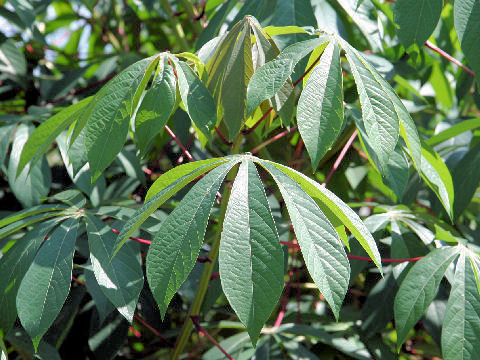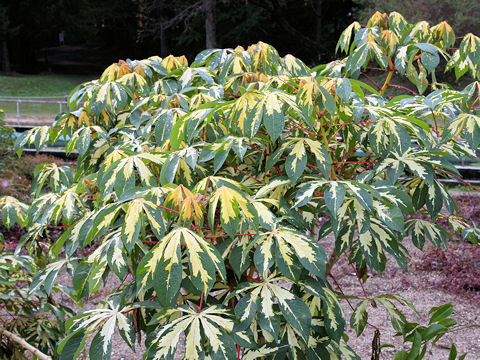 |










|

|
メキシコおよびブラジル、パラグアイが原産です。ペルーでは4000年前、メキシコでは2000年前にはすでに栽培されていました。今では世界中の熱帯・亜熱帯地方で栽培されています。高さは2〜3メートルになり、茎の基部からでた根が「ダリア」のような塊根になります。これが食用になりますが、青酸を含んでいて有毒なため、水で晒したり加熱して利用されます。
写真中2・下は園芸品種の「斑入りキャッサバ(cv. Variegata)」。
|

|
トウダイグサ科キャッサバ属の常緑小低木で、学名は Manihot esculenta。英名は Cassava、Manioc、Tapioca plant。
|

|
The Cassava (Manihot esculenta) belongs to Euphorbiaceae (the Spurge family). It is an evergreen shrub that native to Mexico, Brazil and Paraguay. It has been cultivated for food before 4000 years ago in Peru and before 2000 years ago in Mexico. It is cultivated widely nowadays in tropical and sub-tropical areas. This herb can reach 2-3 m in height and bears dahlia-like tuberous roots. The tuberous roots contain toxic hydrocyanic acid, therefore they are used for food after boiling or soaking in water. The bottom 3 photos are a caltivar 'Variegata'.
|

|
[上・中1] 大阪府交野市「大阪市大付属植物園」にて、2006年09月29日撮影。
[中2] 同上にて、2005年09月15日撮影。
[下] 同上にて、2007年11月10日撮影。
[中3] アメリカ・テキサス州「フォートワース植物園」にて、2006年04月29日撮影。(photo by Jon Suehiro)
|






